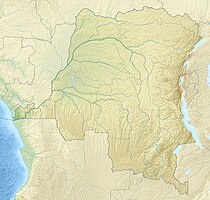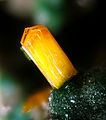Musonoi mine
| Musonoi mine | |||
|---|---|---|---|
| General information about the mine | |||
| Radial tufts of cuprosklodovskite approx. 1 cm in size, covered with yellow guilleminite from the Musonoi mine | |||
| Mining technology | Open pit | ||
| Information about the mining company | |||
| Start of operation | 1940 | ||
| End of operation | 1988 | ||
| Funded raw materials | |||
| Degradation of | Copper-cobalt-manganese-uranium deposit, rich in palladium and selenium | ||
| Geographical location | |||
| Coordinates | 10 ° 42 '39.2 " S , 25 ° 23' 56.5" E | ||
|
|||
| Location | Musonoi | ||
| province | Lualaba | ||
| Country | Democratic Republic of Congo | ||
The Musonoi Mine was an open pit mine in the copper belt 2 km northwest of the city of Kolwezi in the province of Lualaba in the Democratic Republic of the Congo . The open pit is particularly known for its variety of secondary uranium minerals , as well as for its richness in selenium and palladium . The deposit has been mined since the 1940s and has been depleted since 1988.
geology
The Kolwezi region contains more than 50% of the cobalt and copper of the entire former Katanga province . The extent of the ore body is about 25 × 12 km. It consists of layers of torbernite (Cu (UO 2 ) 2 (PO 4 ) 2 · 10-12H 2 O), digenite (Cu 9 S 5 ), bornite (Cu 5 FeS 4 ), chalcopyrite (CuFeS 2 ) and carrollite ( Cu (Co, Ni) 2 S 4 ) under a green oxidation zone. The lower ore body consists of silicate dolomite on red sandstone . The upper ore body consists of dolomitic shale .
Type localities
The Musonoi mine produced seven minerals, which have their type locality here:
- Demesmaekerite (Pb 2 Cu 5 (UO 2 ) 2 (SeO 3 ) 6 (OH) 6 · 2H 2 O)
- Derriksite (Cu 4 (UO 2 ) (SeO 3 ) 2 (OH) 6 )
- Guilleminite (Ba (UO 2 ) 3 (SeO 3 ) 2 O 2 · H 2 O)
- Kolwezite ((Cu, Co) 2 (CO 3 ) (OH) 2 )
- Marthozite (Cu [(UO 2 ) 3 | O 2 | (SeO 3 ) 2 ] · 8 H 2 O)
- Oosterboschite ((Pd, Cu) 7 Se 5 )
- Verbeekit (PdSe 2 )
Of these minerals, derriksite is the only one known exclusively from Musonoi.
Other minerals
By metasomatic transformations the next musonoi mine's copper and cobalt especially rich in uranium , vanadium , selenium , lead , chromium and molybdenum . Therefore selenium-rich digenites (Cu 9 S 5 ), selenium-rich covellins (CuS), copper- and palladium- rich trogtalites (CoSe 2 ), oosterboschites and verbeekites have been found in Musonoi .
A total of 62 minerals were found in Musonoi. These include the classical copper minerals such as chalcocite (Cu 2 S), chrysocolla (Cu 2-x Al x (H 2-x Si 2 O 5 ) (OH) 4 · nH 2 O (x <1)) , Malachite (Cu 2 (CO 3 ) (OH) 2 ) or torbernite (Cu (UO 2 ) 2 (PO 4 ) 2 · 12H 2 O). However, less widespread minerals such as berzelianite (Cu 2 Se), cobaltomenite (CoSeO 3 · 2H 2 O), merenskyite (PdTe 2 ), mottramite (Pb (Cu, Zn) [OH | VO 4 ]), Palladite (Pd 17 Se 15 ), the very rare pseudojohannite (Cu 6.5 (UO 2 ) 8 (SO 4 ) 4 O 8 (OH) 5 · 25H 2 O) (new description 2006), roubaultite (Cu 2 (UO 2 ) 3 (OH) 10 · 5H 2 O), Sengierite (Cu 2 (UO 2 ) 2 V 2 O 8 · 6H 2 O) and very good levels of Vandenbrandeit (Cu (UO 2 ) (OH) 4 ) found.
- Minerals from Musonoi
Malachite with cobalto calcite
Tyuyamunit on malachite
Web links
Individual evidence
- ^ VDC Daltry: The type mineralogy of Africa: Zaire , In: Annales de la Société Géologique de Belgique. T. 115 (fascicule 1) 1992, pp. 33-62 ( PDF 2.2 MB ; p. 3)
- ^ Musonoi in the Mineralienatlas
- ↑ Peter Laznicka: Giant Metallic Deposits: Future Sources of Industrial Metals. Springer, Heidelberg 2010, p. 442. ( available online in the Google book search)
- ↑ a b Musonoi Mine on Mindat
- ↑ Cassian Pirard, Frédéric Hatert, The Sulfides and Selenides Of The Musonoï Mine, Kolwezi, Katanga, Democratic Republic of Congo, In: The Canadian Mineralogist, 2008, Vol. 46, pp. 219-231 (2008) doi : 10.3749 / canmin .46.1.219







